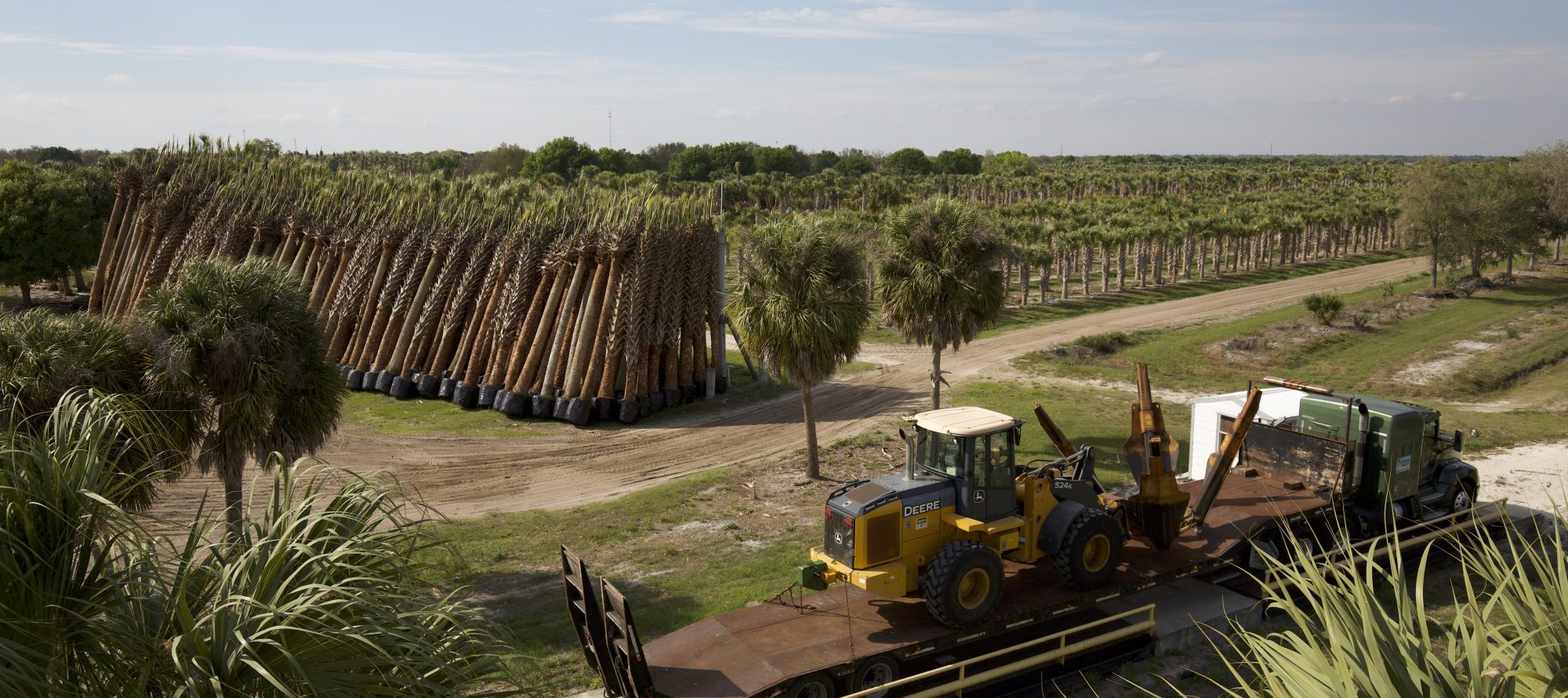
About Us
Griffin Trees Inc. has been a trusted name in the tree-growing industry for 40 years, and is family owned and operated. With 430 Acres of field-grown trees, Griffin Trees specializes in a wide range of oak and palm tree varieties. This includes a 266 acre tree farm in Okeechobee County and multiple locations across Highlands County.
Our trees have been planted across the southeastern United States, including Florida, Georgia, Alabama, North & South Carolina, and extending to Louisiana, Mississippi, and Texas. Griffin Trees have made their mark in iconic locations, such as the Mississippi Govenor’s mansion, Disney World, SeaWorld, Universal Studios, and Margaritaville. Our trees have also been planted at notable private estates including Shaquille O’Neals mansion and Steve Spurrier’s home in Cresent Beach, FL. Our trees have even been featured in MTV’s “Spring Break” productions in Panama City Beach.
We offer comprehensive services, including trees delivery and installation for commercial projects, golf courses, and residential developments. Notable past projects include The Cascades at Isleworth, various gold courses in Orlando and South Florida.
Since June 2007, our Root Enhanced/Regenerated Sabal Palms have been used in numerous Florida Department of Transportation projects statewide, establishing a new benchmark in palm tree transplantation. Griffin Trees, the proud innovator of this process, also offers fully hardened-off/regenerated Bismarkia Palms, among other varieties in our diverse tree inventory.
If you have any questions or would like to learn more about our services, please do not hesitate to contact us.

Ribbon Palm
Scientific Name: Livistona Decipiens (liv-i-STON-a-dee-SIP-ee-enz)
Height: 30’
Growth Rate: Slow to Moderate
USDA Hardiness: 23 Degrees Fahrenheit; recoverable
Drought Tolerances: Moderate
Salt Tolerance: Low
Soil Preference: Widely Adaptable
Light Requirement: Moderate to High
Uses: Specimen Tree
Pest Problem: None Reported
Disease Problem: None Reported
Cabbage Palm
Scientific Name: Sabal Palmetto (SAI-bahl pahl-MET-toe)
Height: 40’
Growth Rate: Slow
USDA Hardiness: No Damage at 15 Degrees Fahrenheit
Drought Tolerances: High
Salt Tolerance: Moderate
Soil Preference: Widely Adaptable
Light Requirement: High
Uses: Specimen Tree
Pest Problem: Palmetto Weevils
Mule Palm
Scientific Name: Butiagrus Nabonnandii (Mule Palm)
**Hybrid of a Pindo and a Queen Palm. The appearance of the hybrids can vary depending on the individual characteristics of the parent plant.**
Height: 15’-25’
Growth Rate: Slow
USDA Hardiness: 15 Degrees Fahrenheit; Possible even 10
Drought Tolerances: High
Salt Tolerance: Low
Soil Preference: Widely Adaptable
Light Requirement: Moderate to High
Uses: Specimen Tree
Bismark Palm
Scientific Name: Bismarckia Nobilis (Bismarck Palm)
Height: 30’-50’
Spread: Up to 20’ wide
Growth Rate: Slow
USDA Hardiness: Damaged but will recover at 26 degrees
Drought Tolerances: High
Salt Tolerance: Low
Soil Preference: Widely Adaptable
Light Requirement: High
Uses: Specimen Tree
Live Oak, Southern Live Oak, American Live Oak, Virginia Live Oak
Scientific Name: Quercus Virginiana
Height: 30’
Spead: 30’-100’
Growth Rate: Medium
USDA Hardiness: Zones 7-11
Drought Tolerances: High
Salt Tolerance: Medium
Soil Preference: Widely Adaptable, Well Drained
Light Requirement: Medium. High
Uses: Specimen Tree
Did you know…
Did you know that the Sabal Palm root system is unlike other root systems? When the roots of a sabal palm are cut they become non-functional and have to generate new roots from the center of the ball.
Our root enhanced/regenerated sabals are initially dug in the field and hurricane cut. The palms are then re-planted in a nursery environment, and are started on a consistent irrigation, and fertilization program.
The tree then re-grows new roots and the head flushes back out. The process takes about 6 months for the tree to become hardened-off or cured and about 9 months to a year to have a full head again. The trees can be tagged at our nursery unlike when they are dug in the field. The customer literally has thousands to choose from.
When our sabal palm is sold as a root enhanced/regenerated sabal, the palm is re-dug without disturbing the ball of the tree and the roots are visible through the stretch wrap. This rootball is now one big solid mass. This process is similar to a root bound potted plant. With plenty of water, the transplanting process is virtually fool proof. The customer now has immediate gratification and the landscaper has eliminated the replacement problem.
Sabal palms need an extremely large amount of water for the first few months after the palm is dug. Sabals with fronds left on the tree in the field have a greater chance of the fronds turning brown. The fronds will eventually have to be removed, typically to the bud. It is extremely stressful for the tree to regenerate new roots from the center of the ball while trying to maintain enough moisture to keep the fronds green.
Hurricane cut sabals have been the normal process for our industry since the late 70’s, early 80’s. We realized that the survivability of the sabal palm increased drastically by hardening off the palm. The landscaper has accepted the hurricane cut process but continues to ask and want a sabal palm with a full head left on for immediate gratification. We can now offer landscapers a sabal palm that can be transplanted from a nursery environment and have a superior root enhanced system and a newly developed canopy that will insure a greater survivability and give immediate gratification.
